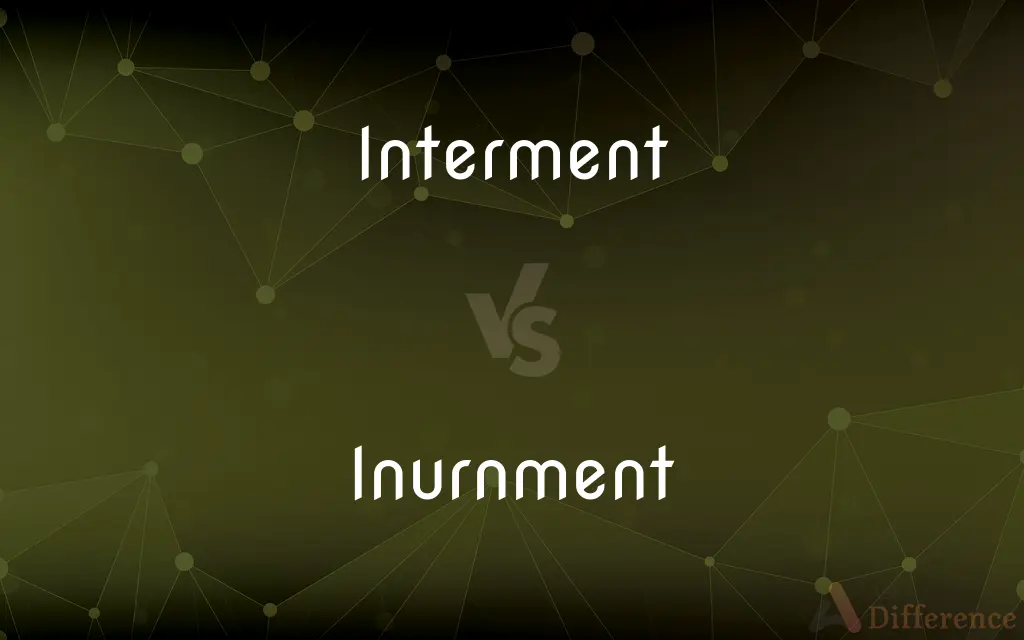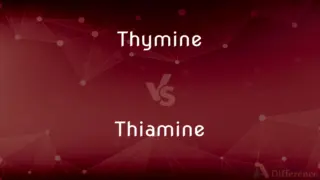Interment vs. Inurnment — What's the Difference?
By Tayyaba Rehman — Updated on August 22, 2023
Interment refers to the burial of a body in the ground, while inurnment refers to placing cremated remains in an urn or niche.

Difference Between Interment and Inurnment
Table of Contents
ADVERTISEMENT
Key Differences
Interment traditionally pertains to the act of burying a deceased body in the earth. This burial can be directly into the soil or within a burial vault or casket. On the other hand, inurnment is the process of placing cremated remains into an urn or a dedicated space like a niche in a columbarium. Both practices respect the memory of the departed but cater to different funeral preferences.
Interment often involves a graveside service where loved ones gather to pay their last respects. The presence of the casket and the act of lowering it into the ground can provide a sense of closure for many. Inurnment, dealing primarily with cremains, can also involve a ceremony where the urn is placed in its final resting place. Both ceremonies provide a meaningful way to remember the deceased.
When it comes to location, interment takes place in cemeteries or burial grounds. The plot of land may vary in size depending on the type of burial. In contrast, inurnment can occur in various places: from a family's home, where the urn is displayed, to a columbarium or a mausoleum. This offers flexibility to families in terms of the final resting place.
Interment has a longer history and is often seen in cultures and religions worldwide, reflecting deep-rooted traditions and beliefs about life after death. Inurnment, although ancient, has gained renewed interest in modern times due to space constraints, environmental concerns, and personal preferences. Regardless of choice, both interment and inurnment serve to honor and commemorate the deceased.
Comparison Chart
Definition
Burial of a body in the ground
Placement of cremains in an urn or niche
ADVERTISEMENT
Typical Location
Cemeteries or burial grounds
Columbarium, mausoleum, or home
Physical Element
Body in casket or vault
Cremated remains
Ceremony
Graveside service
Service at columbarium or chosen location
Historical Prevalence
Widespread across cultures
Ancient but renewed modern interest
Compare with Definitions
Interment
The burial of a corpse in a grave or tomb, typically with funeral rites
Interments took place in the churchyard
The day of interment
Inurnment
The act of placing something in an urn.
Interment
The act of burying a dead body.
After the service, the interment took place at the local cemetery.
Inurnment
The process of setting cremains in a designated place.
Inurnment allowed the family to keep their loved one close.
Interment
The placing of a deceased body into a grave or tomb.
The family gathered for the interment of their grandfather.
Inurnment
A ceremony associated with the ashes of the deceased.
Many attended the inurnment to pay their respects.
Interment
A funeral rite resulting in burial.
The interment was scheduled for the afternoon.
Inurnment
The act of placing cremated remains in an urn.
After the cremation, an inurnment ceremony was held.
Interment
A state of being buried in the ground.
Her interment was beside the old oak tree.
Inurnment
Storing cremains in a niche or special location.
The family chose inurnment in a columbarium near the church.
Interment
The process of laying to rest in a designated space.
The interment followed the memorial service.
Inurnment
Securing cremated remains in a permanent or semi-permanent manner.
The inurnment took place on the family's mantelpiece.
Interment
The act of burying a dead body; burial.
Interment
The act or ritual of interring or burying.
Interment
The act or ceremony of depositing a dead body in the earth; burial; sepulture; inhumation.
Interment
The ritual placing of a corpse in a grave
Common Curiosities
What is interment?
Interment refers to the burial of a deceased body in the ground, usually within a casket or burial vault.
Where does inurnment usually take place?
Inurnment can occur in various places, from a family's home to a columbarium or mausoleum.
Can interment be related to cremation?
While interment primarily deals with burying a full body, cremated remains can be interred in burial plots too, albeit the term is more commonly associated with full-body burials.
What is inurnment?
Inurnment pertains to placing cremated remains into an urn or a dedicated space like a niche in a columbarium.
Are interment and inurnment the same thing?
No, interment deals with burying a full body, while inurnment handles the placement of cremated remains.
Is one method more environmentally friendly than the other?
Both have environmental considerations. Inurnment, due to the process of cremation, uses energy but saves land space, whereas traditional interment may utilize more land.
Which method is older, interment or inurnment?
Interment, or burying the dead, is a practice that dates back millennia across many cultures, but inurnment also has ancient origins in various societies.
Is inurnment more cost-effective than interment?
In many cases, inurnment can be more cost-effective due to savings on caskets, burial plots, and related expenses.
What religious or cultural practices might influence a choice between interment and inurnment?
Many religions have specific beliefs and practices around death, which might favor interment, such as Christianity, Islam, and Judaism, while others might be more open to inurnment or have specific rituals associated with cremains.
Can a family choose both interment and inurnment?
Yes, some families might choose to inter a body and later exhume it for cremation and inurnment, or vice versa, depending on cultural, personal, or logistical reasons.
Share Your Discovery

Previous Comparison
Thymine vs. Thiamine
Next Comparison
Cinder vs. CoalAuthor Spotlight
Written by
Tayyaba RehmanTayyaba Rehman is a distinguished writer, currently serving as a primary contributor to askdifference.com. As a researcher in semantics and etymology, Tayyaba's passion for the complexity of languages and their distinctions has found a perfect home on the platform. Tayyaba delves into the intricacies of language, distinguishing between commonly confused words and phrases, thereby providing clarity for readers worldwide.
















































